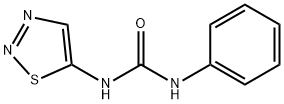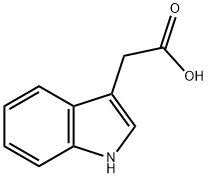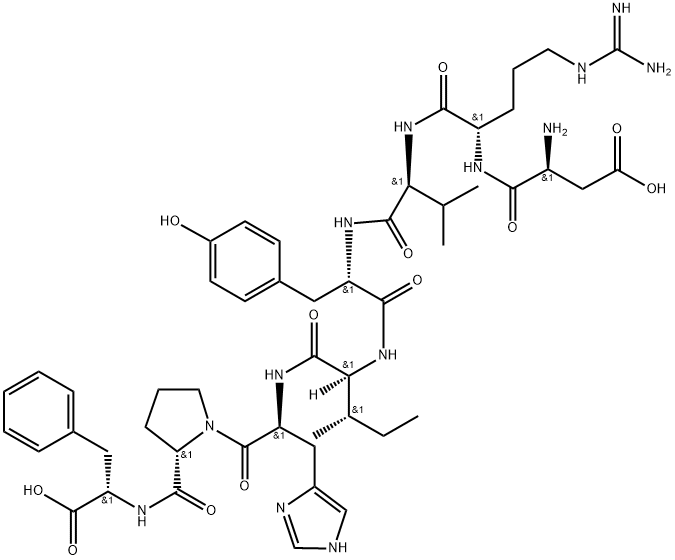Thidiazuron
Synonym(s):1-Phenyl-3-(1,2,3-thiadiazol-5-yl)urea;TDZ
- CAS NO.:51707-55-2
- Empirical Formula: C9H8N4OS
- Molecular Weight: 220.25
- MDL number: MFCD00078723
- EINECS: 257-356-7
- SAFETY DATA SHEET (SDS)
- Update Date: 2025-07-04 15:15:28

What is Thidiazuron?
Chemical properties
The pure product is a white odorless and tasteless crystalline solid. m.p.210~212.5°C (decomposition at 217°C), vapor pressure 4×10-9Pa) (25°C). Solubility at 25°C: dimethyl sulfoxide>500g/L, dimethylformamide>500g/L, cyclohexanone 21.5g/L, acetone 8g/L, methanol 4.5g/L, ethyl acetate 0.8 g/L, hexane 6mg/L, insoluble in aliphatic and aromatic hydrocarbons, solubility in water 31mg/L. The partition coefficient is 59 (pH=7.3). Stable below 200°C; stable to water at room temperature, half-life > 24d; half-life in soil < 60d.
The Uses of Thidiazuron
Thidiazuron is a non-purine containing urea derivative with cytokinin activity. Thidiazuron is used as a cotton defoliant and a plant growth regulator in tissue culture.
The Uses of Thidiazuron
Plant growth regulator used to defoliate cotton to facilitate harvesting.
What are the applications of Application
Thidiazuron is a urea derivative which acts as a cytokinin-active plant growth regulator
Definition
ChEBI: Thidiazuron is a member of ureas.
General Description
Thidiazuron is a systemic herbicide, widely employed as an effective plant growth regulator and pre-harvest defoliant for crops such as cotton.
Agricultural Uses
Herbicide, Defoliant, Plant growth regulator: Used primarily as a cotton defoliant in order to increase the harvest yield. Not applied to food crops. Not approved for use in EU countries. Registered for use in the U.S. U.S. Maximum Allowable Residue Levels for Thidiazuron and its aniline-containing metabolites in or on the following food commodities: [40 CFR 180.403(a)]: cattle, fat 0.4 ppm; cattle, meat 0.4 ppm; cattle, meat byproducts 0.4 ppm; cotton, gin byproducts 24.0 ppm; cotton, undelinted seed 0.3 ppm; goat, fat 0.4 ppm; goat meat 0.4 ppm; goat, meat byproducts 0.4 ppm; hog, fat 0.4 ppm; hog, meat 0.4 ppm; hog, meat byproducts 0.4 ppm; horse, fat 0.4 ppm; horse, meat 0.4 ppm; horse, meat byproducts 0.4 ppm; milk 0.05 ppm; sheep, fat 0.4 ppm; sheep, meat 0.4 ppm; sheep, meat byproducts 0.4 ppm.
Agricultural Uses
Thidiazuron is substituted urea that is used to defoliate cotton plants. Thidiazuron, which has cytokinin activity, is one of the many harvesting aids needed in agriculture.
Trade name
DAZE®; DEFOLIT®; DROPP®; GINSTAR EC® (thidiazuron + diuron); LEAFLESS® Tthidiazuron; SN 49537®
Safety Profile
Moderately toxic by ingestion. Experimental reproductive effects. When heated to decomposition it emits toxic fumes of SOx and NOx.
Environmental Fate
Soil. The reported half-life in soil is approximately 26–144 days (Hartley and Kidd,
1987).
Photolytic. Rapidly converted to the photoisomer, 1-phenyl-3-(1,2,5-thiadiazol-3-
yl)urea (Worthing and Hance, 1991). When thidiazuron adsorbed by soil was exposed to
UV light (λ <290 nm), 1-phenyl-3-(1,2,5-thiadiazol-3-yl)urea formed as the majo
Properties of Thidiazuron
| Melting point: | 213°C |
| Density | 1.3493 (rough estimate) |
| refractive index | 1.6390 (estimate) |
| storage temp. | Sealed in dry,2-8°C |
| solubility | Soluble in DMSO |
| form | neat |
| pka | 12.06±0.70(Predicted) |
| form | Solid |
| color | Light yellow to yellow |
| Merck | 13,9384 |
| BRN | 1078092 |
| CAS DataBase Reference | 51707-55-2(CAS DataBase Reference) |
| EPA Substance Registry System | Thidiazuron (51707-55-2) |
Safety information for Thidiazuron
| Signal word | Warning |
| Pictogram(s) |
 Exclamation Mark Irritant GHS07  Environment GHS09 |
| GHS Hazard Statements |
H315:Skin corrosion/irritation H319:Serious eye damage/eye irritation H335:Specific target organ toxicity, single exposure;Respiratory tract irritation H410:Hazardous to the aquatic environment, long-term hazard |
| Precautionary Statement Codes |
P261:Avoid breathing dust/fume/gas/mist/vapours/spray. P264:Wash hands thoroughly after handling. P264:Wash skin thouroughly after handling. P271:Use only outdoors or in a well-ventilated area. P273:Avoid release to the environment. P302+P352:IF ON SKIN: wash with plenty of soap and water. P305+P351+P338:IF IN EYES: Rinse cautiously with water for several minutes. Remove contact lenses, if present and easy to do. Continuerinsing. |
Computed Descriptors for Thidiazuron
| InChIKey | HFCYZXMHUIHAQI-UHFFFAOYSA-N |
New Products
Indole Methyl Resin tert-butyl 9-methoxy-3-azaspiro[5.5]undecane-3-carboxylate Boc-His(Boc)-OH 2-CTC Resin 4-Chloro-7-tosy1-7Hpyrrolo[2,3-d]pyrimidine 5,7-Dibromo-1H-indole 2,5-dichloro-N-hydroxy-4,6-dimethylpyridine-3-carboximidamide 2,2-Dimethoxy-7-azaspiro[3.5]nonane hydrochloride 4-chloromethyl-5-methyl-1,3-dioxol-2-one (DMDO-Cl) R-2-BENZYLOXY PROPIONIC ACID 1,1’-CARBONYLDIIMIDAZOLE 1,1’-CARBONYLDI (1,2-4 TRIAZOLE) N-METHYL INDAZOLE-3-CARBOXYLIC ACID 4-((2-hydroxyethyl)thio)benzoic acid 1-(TERT-BUTOXYCARBONYL)-2-PYRROLIDINONE Methyl 6-methylnicotinate 3-Pyridineacrylic acid tert-Butyl carbazate TETRAHYDRO-2H-PYRAN-3-OL 2-((4-morpholinophenylamino) (methylthio) methylene) malononitrile 3-(4-morpholinophenylamino)-5-amino-1H-pyrazole-4-carbonitrile 2,4-dihydroxybenzaldehyde 1,3-Diethyl-1,3-Diphenylurea Methyl 2-methylquinoline-6-carboxylateRelated products of tetrahydrofuran








You may like
-
 Thidiazuron (TDZ) for tissue culture CAS 51707-55-2View Details
Thidiazuron (TDZ) for tissue culture CAS 51707-55-2View Details
51707-55-2 -
 Thidiazuron 97% CAS 51707-55-2View Details
Thidiazuron 97% CAS 51707-55-2View Details
51707-55-2 -
 Thidiazuron CAS 51707-55-2View Details
Thidiazuron CAS 51707-55-2View Details
51707-55-2 -
 Thidiazuron CAS 51707-55-2View Details
Thidiazuron CAS 51707-55-2View Details
51707-55-2 -
 Pyridine 99.5% HPLC /UV SpectroscopyView Details
Pyridine 99.5% HPLC /UV SpectroscopyView Details
110-86-1 -
 Dibutyl PhthalateView Details
Dibutyl PhthalateView Details
84-74-2 -
 Imidazole Spot supply, competitive priceView Details
Imidazole Spot supply, competitive priceView Details
288-32-4 -
 Thiourea 99% ARView Details
Thiourea 99% ARView Details
62-56-6
